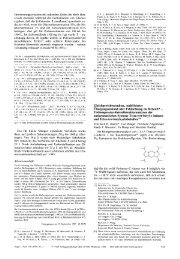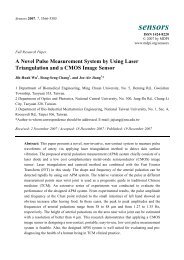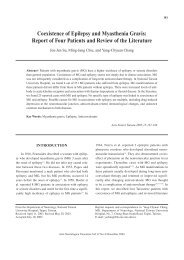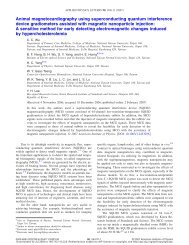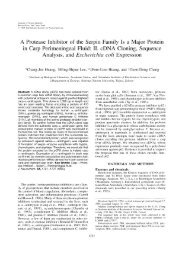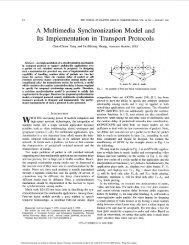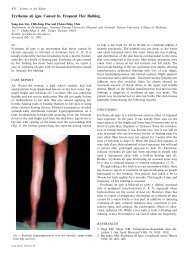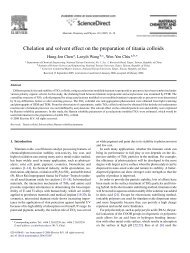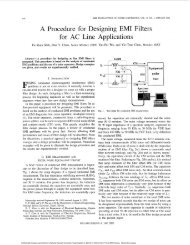Flux motion in YBCO biepitaxial josephson junctions - Applied ...
Flux motion in YBCO biepitaxial josephson junctions - Applied ...
Flux motion in YBCO biepitaxial josephson junctions - Applied ...
You also want an ePaper? Increase the reach of your titles
YUMPU automatically turns print PDFs into web optimized ePapers that Google loves.
IEEE TRANSACTIONS ON APPLIED SUPERCONDUmVITY, VOL. 9, No. 2, JUNE 1999 3931<br />
<strong>Flux</strong> Motion <strong>in</strong> <strong>YBCO</strong> Biepitaxial Josephson Junctions<br />
H. H. Sung<br />
Department of Electrical Eng<strong>in</strong>eer<strong>in</strong>g, Da-Yeh University, ChangHua, Taiwan<br />
S. Y. Yang and H. E. Homg<br />
Department of Physics, National Taiwan Normal University, Taipei, Taiwan<br />
H. C. Yang"<br />
Department of Physics, National Taiwan University, Taipei, Taiwan<br />
AbstrucCWe have measured the current-voltage<br />
characteristics of overdamped long YBa,Cu,O, <strong>biepitaxial</strong><br />
Josephson <strong>junctions</strong>. The velocity-match<strong>in</strong>g step was observed<br />
<strong>in</strong> the current-voltage characteristics with an applied magnetic<br />
field. The presence of velocity-match<strong>in</strong>g steps suggests that the<br />
<strong>biepitaxial</strong> Josephson junction is formed around a dielectric-like<br />
barrier between superconduct<strong>in</strong>g gra<strong>in</strong>s. Anomalous<br />
subharmonic voltage steps were found under microwave<br />
irradiation. The relations between anomaly steps and fluxon<br />
<strong>motion</strong> are discussed.<br />
I. INTRODUCTION<br />
The magnetic flux <strong>motion</strong> <strong>in</strong> a Josephson junction is a<br />
subject of <strong>in</strong>creas<strong>in</strong>g practical <strong>in</strong>terest. S<strong>in</strong>ce it has been<br />
recognized that flux flow three-term<strong>in</strong>al superconduct<strong>in</strong>g<br />
devices theoretically can operate at frequencies up to several<br />
tens of gigahertz [I], [2]. This makes them attractive for high<br />
frequency applications. In a Josephson flux flow transistor, an<br />
external magnetic field is applied to the junction plane. The<br />
field penetrates <strong>in</strong>to the junction <strong>in</strong> form of Josephson<br />
fluxons, each of them carry<strong>in</strong>g one magnetic quantum CDo.<br />
Ideally, if the bias current is less than the maximum<br />
Josephson current Z, the phase difference of order parameter<br />
on opposite sides of the junction is time <strong>in</strong>dependent, and the<br />
fluxons are static. When the bias current exceeds I,, a Lorentz<br />
force will drive fluxons mov<strong>in</strong>g along the junction. An<br />
electromagnetic (EM) wave also can be generated and<br />
propagated along the junction <strong>in</strong> a slowed velocity, or<br />
Swihart velocity [3], E. In a long junction, there are two<br />
ma<strong>in</strong> modes of fluxon <strong>motion</strong>. First is the nonresonant fluxon<br />
<strong>motion</strong>, <strong>in</strong> which fluxons oscillate between the junction edges.<br />
In the second mode, so-called flux flow mode, fluxons are<br />
created at one edge of the junction, move along the junction<br />
once, and are annihilated at the other edge. When the fluxon<br />
velocity U approaches the EM wave phase velocity C, the<br />
current-voltage (I- V) characteristic will show a current step.<br />
This step, often referred as the Eck peak [4] or velocitymatch<strong>in</strong>g<br />
(VM) step, has been observed <strong>in</strong> both low-T, and<br />
high-T, <strong>junctions</strong> [5].<br />
Manuscript received September 15, 1998.<br />
This work was supported by the National Science Council of ROC under<br />
Grant Nos. NSC 87-2112-M-212-001, NSC 87-2112-M-003-001 and NSC<br />
87-2 112-M-002-002.<br />
This paper reports our observation of the VM step .for<br />
<strong>YBCO</strong> <strong>biepitaxial</strong> Josephson <strong>junctions</strong>. From the step voltage,<br />
V,, the <strong>in</strong>tr<strong>in</strong>sic capacitance C and the quasiparticle loss a of<br />
the <strong>junctions</strong> can be estimated. By study<strong>in</strong>g the response of<br />
these <strong>junctions</strong> to microwave radiation, we observed the<br />
anomaly subharmonic Shapiro steps. These steps are<br />
attributed to the synchronous <strong>in</strong>teractions between<br />
microwave radiation and fluxon oscillation [6].<br />
11. EXPERIMENTS<br />
To fabricate <strong>biepitaxial</strong> Josephson <strong>junctions</strong>, a 50 nmthickness<br />
CeO, buffer was frst deposited onto the MgO[ 1001<br />
substrate by rf sputter<strong>in</strong>g. Part of the CeO, layer was<br />
removed fiom the surface of substrate by Ar ion mill<strong>in</strong>g,<br />
provid<strong>in</strong>g a smooth and sharp <strong>in</strong>terface where the gra<strong>in</strong><br />
boundary will be located. Then, a 200 nm-thickness <strong>YBCO</strong><br />
film was grown on the prepared substrate by rf sputter<strong>in</strong>g.<br />
F<strong>in</strong>ally, the <strong>YBCO</strong> film was patterned by standard<br />
photolithography and etched by Ar ion beam.<br />
The electrical measurements were performed us<strong>in</strong>g the<br />
four-probe method. The current was supplied by a constant<br />
current source (Keithley model 220) and the voltage was<br />
measured by a nanovoltmeter (Keithley model 182). A<br />
magnetic field up to 20 G was applied perpendicular to the<br />
1 -0.5 0 0.5 I<br />
current (mA)<br />
Fig. 1 Current-voltage characteristics of a 3O-km <strong>YBCO</strong> <strong>biepitaxial</strong><br />
Josephson at 57 K.<br />
1051-8223/99$10.00 0 1999 IEEE<br />
Authorized licensed use limited to: National Taiwan University. Downloaded on July 23, 2009 at 05:15 from IEEE Xplore. Restrictions apply.
3938<br />
sample plane from a calibrated solenoid wrapped around the<br />
sample. Microwaves were generated by a microwave<br />
generator (GigaTronics model 7200) and were <strong>in</strong>troduced to<br />
the junction through a waveguide.<br />
111. RESULTS AND DISCUSSION<br />
With no applied magnetic fields or microwave, the I-V<br />
curves of our samples exhibit overdamped resistively shunted<br />
junction-like features at temperatures up to 80 K. Fig. 1<br />
shows the typical I-V characteristics of a 30-pn long <strong>YBCO</strong><br />
<strong>biepitaxial</strong> Josephson junction at 57 K. Due to the thermal<br />
activated phase slippage, the Z- V characteristics show no zero<br />
slope at low current and noise round<strong>in</strong>g curve near the critical<br />
current [7].<br />
Us<strong>in</strong>g a 1 pV criterion, the Zc is estimated to be about 330<br />
pA, the ZP,, is about 12 pV, and Jc= 5.5 kA/cm2 at T = 57 K.<br />
However, these parameters can be raised to 2 mA, 70 pV, and<br />
33 Wcm2 respectively at 25 K. To confirm that the<br />
junction is long, we evaluated the Josephson penetration<br />
depth<br />
h,= (q427cpJc (t+2hL))’”,<br />
where po is the vacuum permeability, t is the thickness of<br />
junction barrier, and h, is London penetration depth. Take a<br />
value of A, = 140 nm for the <strong>YBCO</strong> film [8] and I + 21, =<br />
2h,, thus the h, is about 4 pm and much small than the<br />
junction length. The magnetic field dependence of critical<br />
current at 25 K is illustrated <strong>in</strong> Fig. 2. It can be seen that the<br />
Z,(B) dependence shows pronounced deviations fkom the<br />
Fraunhofer pattern. The non-Fraunhofer-like I@)<br />
characteristic has been attributed to crystall<strong>in</strong>e microstructure<br />
and drl_yl symmetry [9], [lo]. S<strong>in</strong>ce the applied magnetic<br />
field is perpendicular to the substrate, the magnetic focus<br />
must be considered. Although the curve has lost the<br />
regularity of Fraunhofer pattern, the simulation results <strong>in</strong> [9]<br />
show that the separation between the two nearby dips <strong>in</strong> Z,(B)<br />
2.0 r I<br />
1.8 : A T=25K<br />
L=30pn<br />
curve is still roughly about one flux quantum <strong>in</strong> the junction,<br />
From Fig. 2, we obta<strong>in</strong> 0.7 G is approximately correspond<strong>in</strong>g<br />
to penetration of one flux quantum <strong>in</strong>to the junction. Thus the:<br />
flux focus factor F due to the perpendicular applied magnetic:<br />
field is about 4.<br />
In order to study flux <strong>motion</strong> <strong>in</strong> long <strong>YBCO</strong> <strong>biepitaxial</strong><br />
<strong>junctions</strong>, we applied a magnetic field to a 30-pm junction to<br />
study I-V characteristics <strong>in</strong> flux flow state. Fig. 3 (a) shows<br />
some results at 57 K. S<strong>in</strong>ce the <strong>YBCO</strong> <strong>biepitaxial</strong> <strong>junctions</strong><br />
are overdamped, the VM steps may be obscure <strong>in</strong> the I- V data.<br />
Therefore, we plot the excess current Z, versus V to reveal the:<br />
<strong>in</strong>crease of supercurrent, as the dashed l<strong>in</strong>es <strong>in</strong> Fig. 3 (a)<br />
show. Here I, = I - VIR,,, is the space average dc Supercurrent<br />
across the junction. Figure 3 (b) shows that the voltage of the<br />
<strong>in</strong>creased supercurrent is l<strong>in</strong>early dependent on the applied<br />
field B, and dVJdB is about 22 pVlG. Hence we relate these<br />
voltages to the VM steps. Accord<strong>in</strong>g to [5], the relation of‘<br />
VM step voltage and applied magnetic filed can be written as<br />
V, = (t+2AL)ZFB.<br />
From the value of dV,/dB, we estimate that the EM wave<br />
propagation velocity <strong>in</strong> <strong>YBCO</strong> <strong>biepitaxial</strong> <strong>junctions</strong> is<br />
approximately 2x105 m/s. This is only about 1/50 of value<br />
reported <strong>in</strong> <strong>YBCO</strong>NSZ 0-32” [OOl] tilt bicrystal <strong>junctions</strong><br />
[5]. S<strong>in</strong>ce the Swihart velocity is the upper limit of flux flow<br />
I,=I-VIR, (mA)<br />
0.1 0.15 0.2 0.25 0.3 0.35<br />
30 I<br />
0 0.2 0.4 0.6 0.8 1 .o<br />
I (mA)<br />
I<br />
0.1 0.2 0.3 0.4 0.5 0.6 0.7 0.8 ( 9<br />
B (GI<br />
Fig. 2. Critical current as a f<strong>in</strong>ction of applied magnetic field at 25 K for<br />
the junction with junction length L = 30 pm. Dots are the experimental<br />
data. The l<strong>in</strong>es are guides to the eye.<br />
Fig 3. (a) I-V curves of a 30-pm junction with different applied magnetic<br />
fields B,, B2, B,, B, at 57 K. The average supercurrent I, vs. V curves are<br />
shown as dash l<strong>in</strong>es. The arrows <strong>in</strong>dicate the V,,, voltages where flux flow<br />
resonances occur. B,= 0.31 G, B2 = 0.40 G, B, = 0.58 G, B, = 0.67 G. (b)<br />
VM step voltage V, versus applied magnetic field B of the 30-pm<br />
junction. The solid l<strong>in</strong>e is the l<strong>in</strong>ear fit.<br />
Authorized licensed use limited to: National Taiwan University. Downloaded on July 23, 2009 at 05:15 from IEEE Xplore. Restrictions apply.
3939<br />
30<br />
20<br />
10<br />
S O<br />
9<br />
2 ṿ<br />
-10<br />
-20<br />
-30<br />
1(2 mA/div.)<br />
Fig. 4 I-V curves of a 10-pm junction irradiated with different microwave<br />
frequencies at 67 K. The <strong>in</strong>set shows the first step voltage as a function of<br />
production of microwave frequency and flux quantum vQo, The solid l<strong>in</strong>e<br />
shows l<strong>in</strong>ear fitt<strong>in</strong>g curve.<br />
velocity, the maximum operation frequency of Josephson flux<br />
flow devices is about 20 GHz.<br />
Moreover, the Swihart velocity can be established as<br />
/ ,112<br />
.=.i C(2 A, Eo + t) 1<br />
where c is the light velocity <strong>in</strong> vacuum, E,, is the permittivity<br />
of vacuum, and C is the <strong>in</strong>tr<strong>in</strong>sic capacitance per unit area of<br />
the junction. Accord<strong>in</strong>gly, we obta<strong>in</strong> C = 70 pF/pm2, and a<br />
junction capacitance of 420 pF. S<strong>in</strong>ce our <strong>junctions</strong> show no<br />
hysteresis, this corresponds to a Stewart-McCumber<br />
parameter p, of less than one. Indeed, the p, we calculated is<br />
0.5 < 1, and is consistent with non-hysteresis I-V curves.<br />
Furthermore, the quasiparticle loss<br />
ac=(1/IcR,)(JccD,/2nC)“2 ~1.3 at 57 K. This confirms<br />
that the EM wave can propagate <strong>in</strong> the junction, and flux<br />
flow can be susta<strong>in</strong>ed.<br />
F<strong>in</strong>ally, <strong>in</strong> Fig. 4, we report the I-if characteristics of a 10-<br />
pm junction irradiated with different microwave frequencies<br />
at 67 K. The I-V curves show some constant voltage steps,<br />
such as the well known Shapiro steps. However, the value of<br />
the first step voltage V, divided by the product of microwave<br />
frequency and flux quantum vOo is 0.35, as shown <strong>in</strong> the<br />
<strong>in</strong>set of Fig. 4. There are several mechanisms to expla<strong>in</strong><br />
subharmonic steps. Non-<strong>in</strong>tegral steps have been observed <strong>in</strong><br />
the <strong>YBCO</strong> <strong>biepitaxial</strong> <strong>junctions</strong> [ 111, and <strong>in</strong>terpreted as the<br />
effect of parallel <strong>junctions</strong>. However, parallel <strong>junctions</strong> can<br />
describe the 112, 1/3 steps, and this is not the case here. Twodimensional<br />
Josephson arrays can cause subharmonic steps<br />
when the applied field is such that the number of flux quanta<br />
per unit cell is not an <strong>in</strong>teger [12]. However, the applied<br />
magnetic field does not affect the step voltages <strong>in</strong> our sample.<br />
Other possibilities are the nons<strong>in</strong>usoidal current-phase<br />
relation (CPR) [13], [14] and the effect of flux <strong>motion</strong> <strong>in</strong> a<br />
long junction. The nons<strong>in</strong>usoidal CPR for 45” gra<strong>in</strong> boundary<br />
<strong>YBCO</strong> <strong>junctions</strong> was observed by Il’ichev et al. [15]. Thus,<br />
we cannot rule out the prospect <strong>in</strong> our <strong>YBCO</strong> <strong>biepitaxial</strong><br />
<strong>junctions</strong>. On the other hand, s<strong>in</strong>ce we have observed flux<br />
flow resonance <strong>in</strong> the 30-pm junction, it is reasonable to<br />
exam<strong>in</strong>e the effect of flux <strong>motion</strong>.<br />
For microwave radiation at powers less than the threshold<br />
for flux flow, constant voltage steps can be <strong>in</strong>duced at [6]<br />
V, = (n/m)(vOo).<br />
These voltage steps are due to the synchronous coupl<strong>in</strong>g that<br />
occurs when the fluxon couples to the nth harmonic of the<br />
<strong>in</strong>cident radiation for every m trips across the junction. In<br />
other words, the condition for which V, appears is V~ =<br />
(n/m)v, where v, is the frequency of fluxon oscillation <strong>in</strong> the<br />
junction. If the anomalous subharmonic voltage steps we<br />
observed are caused by <strong>in</strong>teraction between microwave<br />
radiation and fluxon oscillation <strong>in</strong> the long junction, then the<br />
average velocity of flux <strong>motion</strong> U can be calculated us<strong>in</strong>g<br />
-<br />
U = Lv, , where L is the junction length. With the ratio nlrn =<br />
0.35, we obta<strong>in</strong>ed the U= 2.1~10~ m/s for a <strong>YBCO</strong><br />
<strong>biepitaxial</strong> junction at 6 GHz microwave irradiation.<br />
Although the average velocity U is consistent with the upper<br />
limit of fluxon velocity <strong>in</strong> the above discussion, additional<br />
experiments are necessary, such as to determ<strong>in</strong>e the<br />
dependence between junction length and step voltage.<br />
In conclusion, we have studied the I-V characteristics of<br />
<strong>YBCO</strong> <strong>biepitaxial</strong> Josephson <strong>junctions</strong> under magnetic fields<br />
and microwave irradiation. The VM steps were observed <strong>in</strong><br />
the 30-pm <strong>junctions</strong> at 57 K. This suggests that EM waves<br />
can propagate along the junction, and the junction<br />
capacitance cannot be neglected. However, the Stewart-<br />
McCumber parameter of the junction is about 0.5, which still<br />
satisfies the non-hysteresis I- V characteristics shown <strong>in</strong> our<br />
<strong>junctions</strong>. F<strong>in</strong>ally, we observed the anomalous subharmonic<br />
voltage steps <strong>in</strong> the microwave irradiated I-V curves. The<br />
anomaly cannot be attributed to the effects of parallel<br />
<strong>junctions</strong> or 2D junction arrays. However, the other two<br />
possible mechanisms, flux <strong>motion</strong> <strong>in</strong> a long junction and<br />
nons<strong>in</strong>usoidal CPR, require further experiments <strong>in</strong> order to<br />
determ<strong>in</strong>e which is the cause.<br />
REFERENCES<br />
[l] J. Mannhart, “High-T, transistors,” Supercond. Sci. Technol., vol. 9, pp.<br />
49-67, 1996.<br />
[2] J. E. Nordman, “Superconductive amplify<strong>in</strong>g devices us<strong>in</strong>g fluxon<br />
dynamics,” Supercond. Sci. Technol., vol. 8, pp. 681-699, 1995.<br />
[3] J. C. Swihart, “Field Solution for a Th<strong>in</strong>-Film Superconduct<strong>in</strong>g Strip<br />
Transmission L<strong>in</strong>e,”J. Appl. Phys. vol. 32, pp. 461-469, 1961.<br />
[4] R. E. Eck, D. J. Scalap<strong>in</strong>o, and B. N. Taylor, “SELF-DECTION OF THE<br />
ac JOSEPHSON CURRENT,”Phys. Rev. Lett., vol. 13, pp. 15-18, 1964.<br />
[SI Y. M. Zhang, D. W<strong>in</strong>kler, P.-A. Nilsson, and T. Claeson, “Josephson fluxflow<br />
resonance <strong>in</strong> overdamped long YBa,Cu,O, gra<strong>in</strong>-boundary<br />
<strong>junctions</strong>,” Phys. Rev. B, vol. 51, pp. 8684-8687, 1995.<br />
[6] M. Scheuermann, J. T. Chen, and Jhy-Ju<strong>in</strong> Chang, “Interaction between<br />
microwaves and a s<strong>in</strong>gle vortex <strong>in</strong> a long Josephson tunnel junction,” J.<br />
Authorized licensed use limited to: National Taiwan University. Downloaded on July 23, 2009 at 05:15 from IEEE Xplore. Restrictions apply.
3940<br />
Appl. Phys., vol. 54, pp. 3286-3290, 1983.<br />
steps <strong>in</strong> high-T, gra<strong>in</strong> boundq<strong>junctions</strong>,” Appl. Phys. Lett., vol. 62, pp.<br />
[7] V<strong>in</strong>ay Ambegaokar and B. I. Halper<strong>in</strong>, “VOLTAGE DUE TO 3357-3359, 1993.<br />
THERMAL NOISE IN THE dc JOSEPHSON EFFECT,” Phys. Rev. Lett.<br />
vol. 22, pp. 486-1366, 1963.<br />
[8] M. C. Nuss, K. W. Goossen, P. M. Mankiewich, and M. L. O’Malley,<br />
“Terahertz surface impedance of th<strong>in</strong> YBa2Cu,07 superconduct<strong>in</strong>g<br />
films,” Appl. Phys. Lett. vol. 58, pp. 2561-2563, 1991.<br />
[9] C. A. Copetti, F. Ruders, B. Oelze, Ch. Buchal, B. Kabius, and J. W. Seo,<br />
“Electrical properties of 45” gra<strong>in</strong> boundaries of epitaxial YBaCuO,<br />
dom<strong>in</strong>ated by crystall<strong>in</strong>e microstructure and d-wave-symmetry,” Physzcu<br />
C, vol. 253, pp. 63-70, 1995<br />
[I21 S. F. Benz, M. S. Rzchowski, M. T<strong>in</strong>kham, and C. J. Lobb, “Fractional<br />
Giant Shapiro Steps and Spatially Correlated Phase Motion <strong>in</strong> 2D<br />
Josephson Arrays,” Phys. Rev. Lett., vol. 64, pp.693-696, 1990<br />
[I31 D. B. Sullivan, Robert L. Peterson, V. E. Kose, and J. E. Zimmerman,<br />
“Generation of Harmonics and Subharmonics of the Josephson<br />
Oscillation,” J. Appl. Phys., vol. 41, pp.4865-4873, 1970.<br />
[14] K. H. Gundlach and J. Kadlec, “ac Josephson-Like Effect with L<strong>in</strong>ear<br />
Periodic Current-Phase Relation,” J. Low Temp. Phys., vol. 26, pp. 603-<br />
612, 1977.<br />
[IO] H. Hilgenkamp, J. Mannhart, and B. Mayer, “Implications of dx~-y~ [I51 E. Il’ichev, V. Zakosarenko, R. P. J. IJsselsteijn, V. Schultze, H.-G<br />
Meyer, and H. E. Hoenig, “Nons<strong>in</strong>usoidal Current-Phase Relationship of<br />
symmetry and facet<strong>in</strong>g for the transport properties of gra<strong>in</strong> boundaries <strong>in</strong> Gra<strong>in</strong> Boundary Josephson Junctions <strong>in</strong> High-T, Superconductors,” Phys.<br />
high-T, superconductors,” Phys. Rev. B, vol. 53, pp. 14586-14593, 1996 Rev. Lett., vol. 81, pp. 894-897, 1998<br />
[ll] E. A. Early, A. F. Clark, and K. Char, “Half-<strong>in</strong>tegral constant voltage<br />
Authorized licensed use limited to: National Taiwan University. Downloaded on July 23, 2009 at 05:15 from IEEE Xplore. Restrictions apply.



